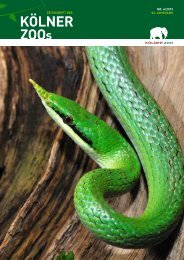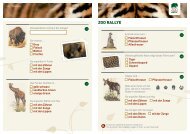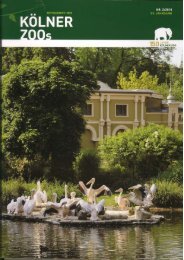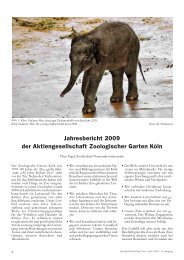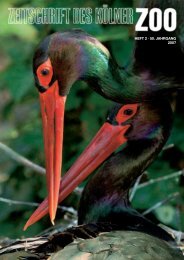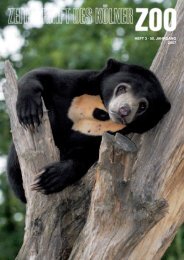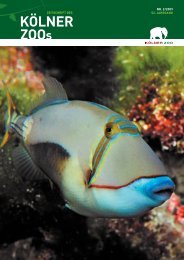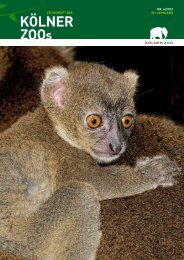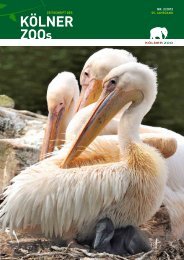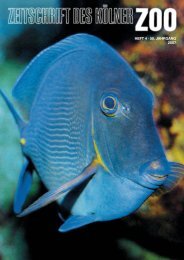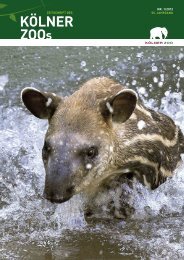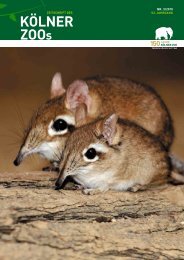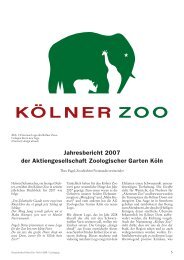Nr. 2/2011, 54. Jahrgang - Kölner Zoo
Nr. 2/2011, 54. Jahrgang - Kölner Zoo
Nr. 2/2011, 54. Jahrgang - Kölner Zoo
Sie wollen auch ein ePaper? Erhöhen Sie die Reichweite Ihrer Titel.
YUMPU macht aus Druck-PDFs automatisch weboptimierte ePaper, die Google liebt.
eproduktiven Paars pflanzen sich<br />
selbst nicht fort und bleiben ein Leben<br />
lang bei ihrer Familie. Die sehr langsame<br />
vor- und nachgeburtliche Entwicklung<br />
der Tiere könnte ein Grund<br />
für die eusoziale Struktur sein, denn<br />
die Mütter sind auf ihren Partner (und/<br />
oder Helfer) angewiesen. Forschungsbedarf<br />
besteht unter anderem zur Klärung<br />
der Frage, warum reproduktive<br />
Tiere durchschnittlich doppelt so alt<br />
werden wie nicht reproduktive Tiere.<br />
Summary<br />
The Ansell’s mole-rat (Fukomys anselli)<br />
is a subterranean rodent of the family<br />
Bathyergidae which has a distribution<br />
confined to the African continent. The<br />
taxonomy of the bathyergids has been<br />
revised repeatedly in the past years,<br />
and several new mole-rat species of the<br />
genera Fukomys and Cryptomys are yet<br />
to be described.<br />
Fukomys mole-rats (like other bathyergids)<br />
show many adaptations to the<br />
subterranean ecotope which is characterized<br />
by darkness, relatively stable<br />
microclimatic conditions, high mechanic<br />
resistance, and low productivity. The<br />
body is cylindrical, and the body<br />
appendages are reduced. The prominent<br />
incisors are used to loosen hard<br />
soil. The intensive study of sensory<br />
biology of mole-rats revealed that the<br />
animals are also well adapted in this<br />
aspect. The well developed sense of<br />
smell is used to search for food and to<br />
recognize family members. Hearing is<br />
specialized to perceive low sound<br />
frequencies which are least dampened<br />
or even amplified in subterranean<br />
tunnels. The eyes are reduced, but all<br />
structures of a typical mammalian eye<br />
are present. The retina is arranged in<br />
layers and contains an unexpectedly<br />
high proportion of cones. It is speculated<br />
that the eye does not only serve<br />
(color and dark/light) vision but that it<br />
plays a role magnetoreception as well.<br />
Ansell’s mole-rats possess a remarkable<br />
social system: Most of the offspring<br />
of the monogamous founder pair do<br />
not reproduce and remain within the<br />
family for the rest of their life. The<br />
slow pre- and postnatal development<br />
could be a reason for the eusocial<br />
structure, because the queen depends<br />
on her partner (and/or helpers). Future<br />
studies should show why reproductive<br />
animals live on average twice as long as<br />
non-reproductive mole-rats.<br />
Danksagung<br />
Wir möchten uns bei allen studentischen<br />
Hilfskräften und DoktorandInnen,<br />
die sich in den letzten Jahren<br />
liebevoll um die Graumulle im<br />
Essener „Mullarium“ gekümmert haben,<br />
herzlich bedanken. Auch unserem ehemaligen<br />
Tierpfleger, Herrn Rolf<br />
Hohmeister, danken wir für die stets<br />
pünktliche Lieferung der Kost und die<br />
jahrelange Fütterung der Tiere. Gerd<br />
Hamann sorgte für die Ausstattung<br />
(Labyrinthe, Rundarenen, Spezialanfertigungen<br />
etc.) und beklagte sich (fast)<br />
nie, auch wenn es mal ganz schnell gehen<br />
musste. Den vielen Examenskandidaten<br />
und DiplomandInnen, die ihre Abschlussarbeiten<br />
über unsere Tiere verfasst<br />
haben, sowie unserer BTA Christiane<br />
Vole sei für die Unterstützung bei<br />
der Datenerhebung gedankt. Danken<br />
möchten wir zudem Marie-Therese<br />
Bappert und Anika Schinköth, dass sie<br />
uns immer schnell und zuverlässig beim<br />
Photoshoppen halfen. Ein großes Dankeschön<br />
geht an unsere Sekretärin, Frau<br />
Ingrid Bechler, die uns den Rücken frei<br />
hält, damit wir hin und wieder auch mal<br />
ein nettes Projekt wie den vorliegenden<br />
Beitrag in Angriff nehmen können.<br />
Schlussendlich danken wir allen, die<br />
uns ihre Fotos für diesen Artikel zur<br />
Verfügung gestellt haben.<br />
Literatur<br />
VAN AARDT, W. J., G. BRONNER,<br />
& R. BUFFENSTEIN (2007): Hemoglobin-oxygen-affinity<br />
and acid-base<br />
properties of blood from the fossorial<br />
mole-rat, Cryptomys hottentotus<br />
pretoriae. Comparative Biochemistry<br />
and Physiology A 147: 50 –56.<br />
BEGALL, S. (1997): The application of<br />
the Gompertz model to describe body<br />
growth. Growth, Development &<br />
Aging 61: 61 –67.<br />
BEGALL, S. & H. BURDA (1998):<br />
Reproductive characteristics and<br />
growth rate in the eusocial Zambian<br />
common mole-rat (Cryptomys sp.,<br />
Bathyergidae). Zeitschrift für Säugetierkunde<br />
63(5): 297 –306.<br />
BEGALL, S., H. BURDA & C. E.<br />
SCHLEICH, Hrsg. (2007): Subterranean<br />
rodents: News from underground.<br />
Springer Heidelberg. 398 pp.<br />
BENNETT, N. C. & C. G. FAULKES F<br />
(2000): African mole-rats. Ecology and<br />
eusociality. Cambridge University<br />
Press: Cambridge, UK. 287 pp.<br />
BRÜCKMANN, G. & H. BURDA<br />
(1997): Hearing in blind subterranean<br />
Zambian common mole-rats (Cryptomys<br />
sp., Bathyergidae, Rodentia). Journal of<br />
Comparative Physiology A 181: 83–88.<br />
BUFFENSTEIN, R. & S. YAHAV<br />
(1991): Is the naked mole-rat Heterocephalus<br />
glaber a poikilothermic or<br />
poorly thermoregulating endothermic<br />
mammal? Journal of Thermal Biology<br />
16: 227–232.<br />
BURDA, H. (1987): Magnetische<br />
Navigation bei den Graumullen, Cryptomys<br />
hottentotus (Bathyergidae)?<br />
Zeitschrift für Säugetierkunde (Suppl.)<br />
61: 12.<br />
BURDA, H. (1989): Reproductive<br />
biology (behaviour, breeding, and<br />
postnatal development) in subterranean<br />
mole-rats, Cryptomys hottentotus<br />
(Bathyergidae). Zeitschrift für Säugetierkunde<br />
54: 360–376.<br />
BURDA, H. (1995): Individual recognition<br />
and incest avoidance in eusocial<br />
common mole-rats rather than reproductive<br />
suppression by parents. Experientia<br />
51: 411 –413.<br />
BURDA, H., S. MARHOLD, T.<br />
WESTENBERGER, R. WILTSCHKO<br />
& W. WILTSCHKO (1990): Magnetic<br />
compass orientation in the subterranean<br />
rodent Cryptomys hottentotus<br />
Bathyergidae. Experientia 46: 528–530.<br />
BURDA, H. & M. KAWALIKA<br />
(1993): Evolution of eusociality in the<br />
Bathyergidae: The case of the giant<br />
mole-rat (Cryptomys mechowii).<br />
Naturwissenschaften 80: 235–237.<br />
BURDA, H., S. BEGALL, O.<br />
GRÜ R TJEN, A. SCHARFF, E. NEVO,<br />
A. BEILES, J. CERVENY & K.<br />
PRUCHA (1999): How to eat a carrot?<br />
Convergence in the feeding behaviour<br />
of subterranean rodents. Naturwissenschaften<br />
86: 325 –327.<br />
BURDA, H., J. ZIMA, A. SCHARFF,<br />
M.MACHOLAN & M. KAWALIKA<br />
(1999): The karyotypes of Cryptomys<br />
anselli i sp. nova and Cryptomys kafuensis<br />
sp. nova: new species of the common<br />
mole-rat from Zambia (Rodentia,<br />
Bathyergidae). Zeitschrift für Säugetierkunde<br />
64: 36–50.<br />
101



